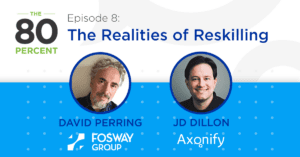4 tips for reskilling your frontline workforce
Reskilling has gone from a vague human resources concept to frank operational reality in six months.
In January, we were discussing future-focused possibilities like “by 2030, demand for human skills—social and emotional soft skills—will grow across all industries by 26% in the U.S. and by 22% in Europe.” Fast forward to July, and we’re dealing with frontline-focused realities, like retailers rapidly reskilling store employees to take on contact center tasks. The COVID-19 pandemic has fundamentally changed the frontline workplace. As a result, employees must relearn how to do their jobs or take on entirely new roles.

I sat down with David Perring, Director of Research at the UK-based analyst group Fosway, to discuss the practical side of reskilling in the current business environment. You can listen to our conversation on episode 8 of The 80 Percent Podcast. Here are four of the biggest takeaways:
1 – Balance today and tomorrow
Operational priorities or strategic vision? Which should take precedence when it comes to your employee development programs? The answer: both. You need to be ready to help employees adapt their knowledge to overcome day-to-day disruption on high-priority topics, like safety, process changes and customer service. At the same time, you also have to think strategically, so you can proactively help employees build the skills they’ll need in the not-so-distant future. If you want your people to do their best work and your business to reach its full potential, you must strike this balance.
“Start to have the conversations with your stakeholders, the senior decision makers. What does this business look like in 12 months time? What does it look like in three years’ time?”
2 – Get specific and measurable
Skills are often poorly defined. For example, what it takes to be a “good communicator” in one role may be very different from what is expected in another. To help people do their best work, you must first clearly define what’s expected of them. Work with your stakeholders and subject matter experts to break down vague skills categories, like communication, safety or sales, into specific, observable behaviors. Determine how these behaviors will be measured on the job so you can assess the ongoing effectiveness of your training programs.
“The challenge becomes helping people understand what good looks like. And enable them to have the practice and input that enables them to be like that.”
3 – Install the plumbing
No one had a pandemic response plan for their organization. However, some companies have been able to deal with operational change more effectively due to the work they had already done to transform their approach to frontline training. These teams had already prioritized tactics such as communication, reinforcement and performance support. They had installed the “digital plumbing” needed to get the right training and resources to the right people at the right time. Then, when the pandemic started, they pivoted these mechanisms to focus on immediate frontline priorities, like health and safety. Moving forward, they will be able to quickly adjust their strategies and strike an ongoing balance between operational needs and future-focused skill development.
“People who had already proceeded down a digital learning avenue found it twice as easy as those who were more immature when it comes to digital learning.”
4 – Put people first
Change is hard. Many frontline employees are being asked to relearn how to do jobs they’ve been doing the same way for years. And that’s on top of the daily challenges we’re all facing during this pandemic. You can’t design an effective reskilling strategy in a silo. You need to get the right people involved so you can truly understand the frontline perspective. Your training programs must fit into their day-to-day reality. They should be simple, relevant and provide clear value. Otherwise, people won’t engage, no matter how good your content is.
“Reach out to the frontline. Don’t just go to the traditional stakeholders so that you’ve got the ‘voice of the customer.’ Find out what they find difficult, the things that they’d like more support around. Start to engage proactively. It will help you come to terms with what the new reality is.”
For more insights from David and his team at Fosway, check out their latest research into the pandemic’s impact on HR. You can also subscribe to The 80 Percent via Apple, Google or Spotify to listen to more frontline-forward stories from experienced global practitioners, influencers and analysts.
Be safe. Be well. And be kind to the frontline.
